Subscribe to trusted local news
In a time of both misinformation and too much information, quality journalism is more crucial than ever. By subscribing, you can help us get the story right.
- Subscription costs less than £1 a week with an annual plan.
Already a subscriber? Log in here.
10
Jan 2021
StrayArt with Johnny Messum: Painting Outdoors

 StrayArt is a monthly column written by Johnny Messum, Director and Founder of art gallery and centre, Messum’s Wiltshire, London and Harrogate. Johnny’s passion is for contemporary art and sculpture.
StrayArt is a monthly column written by Johnny Messum, Director and Founder of art gallery and centre, Messum’s Wiltshire, London and Harrogate. Johnny’s passion is for contemporary art and sculpture.
Each month he will look at art, exhibitions and events across Yorkshire and sometimes further afield with the aim of guiding and inspiring us.
En plein Air painting was a game changer in the sensibilities of Western art. Some of our greatest and most celebrated works of art – think Van Gogh, Monet, Pissarro, Sisley are part of that idiom. Yet it has a refreshingly practical origin that led to the flowering of an entire and enduring art genre. Up until the 19th Century paint was ground and mixed – ideally by an assistant and normally by yourself in a laborious process, in fact this had largely been outsourced to professional mixers who supplied pigment in pigs bladders, an improvement but with obvious limitations.
The advance of mechanics and science led to an American painter John Rand coming up with a means of storing and delivering paint via a zinc tube that could be squeezed, capped and crucially manufactured on a smaller scale to make pigment transportable. Who could have foreseen that convenience and science would sow the seeds for such remarkable flowering of art that continues to this day? The art world had seen nothing like it. Suddenly paintings could be painted “En plein Air” colliding with a rampant affection for the bucolic set fire in this country by Wordsworth and Coleridge and in France by Hugo and Baudelaire.
Painting en plein air in this country started with and is maintained by the New English Arts Club, a revolutionary group of artists founded by Grimsby born Thomas Kennington amongst others. There are degrees of technique to the process all of wihhc are acceptable. Probably the most exemplary is the current President of the New English Arts Club Peter Brown who works outside assiduously regardless of weather or obstacle. Other artists will work in part outside and then from the studio touch up and complete the works. Painting from photographs is very much a no. Light is at the heart of the en plein air principle, it changes constantly so the skilled artist knows how to capture that part of the day they are aiming for it and to return another day if not completed in time.
Perhaps more than anything in a great en plein painting is the sense of place experienced though the eyes of some one who has really stood in that place. Who can not feel the presence of moment in Berthe Morisot’s “Summers Day” 1879 (National Gallery) . Or stood in front of a majestic series of Forest landscape by David Hockney. En plein air painting could perhaps be better described as the En plein air experience. A way to see how the landscape can be captured and translated into pigments. These works are in collections through out the country and some of our most celebrated artists working today continue the principles. However if you are passing- when we are allowed – do drop in and see the collection at Burton Agnes Hall in East Yorkshire it contains one of the most impressive collections of 19th century French paintings outside London - collected by the former owner Marcus Wickham-Boynton - it includes paintings by Corot, Boudin, Renoir and Pissarro - all of whom painted out of doors.
Read More:
In the mean time, let the images of these masterful paintings draw your mind and imagination to the great outdoors, and if you are interested in starting up yourself then a window and vista on the world is a source of wonder, just look at the light.
Messums Yorkshire in 4-6 James Street, Harrogate, in the light of current restrictions, will be holding online exhibitions. From 7 January - 30 January Yorkshire debut shows of two Australian artists - works by sculptor Daneil Agdag and photographer Atong Atem “Self-portaits and family studies”. This will be followed by an exhibition of Views of Yorkshire by Peter Brown President of the New English Art Club, from 4 February to 13 Mach 2021. You can visit the exhibitions on the gallery website: www.messumsyorkshire.com
0